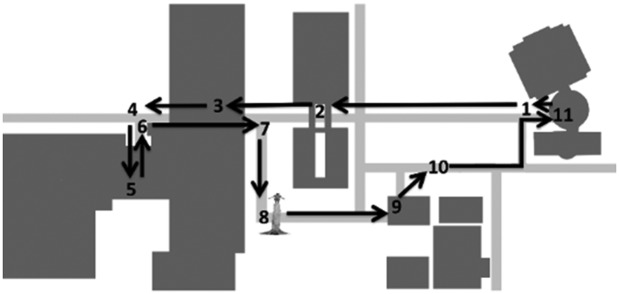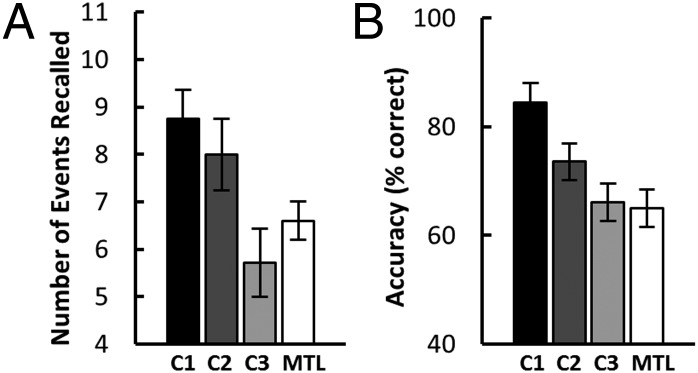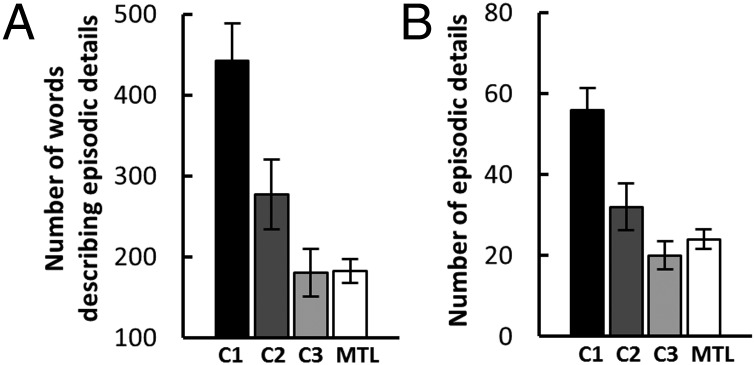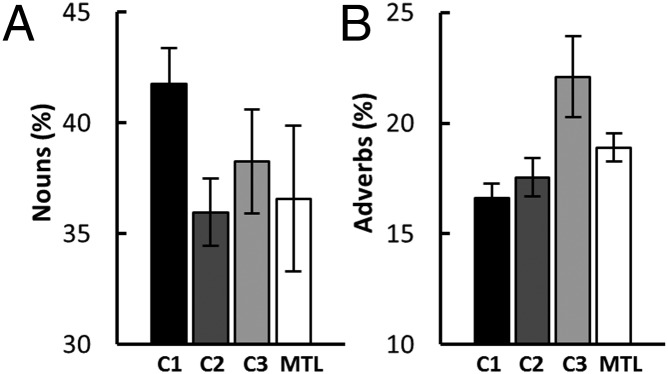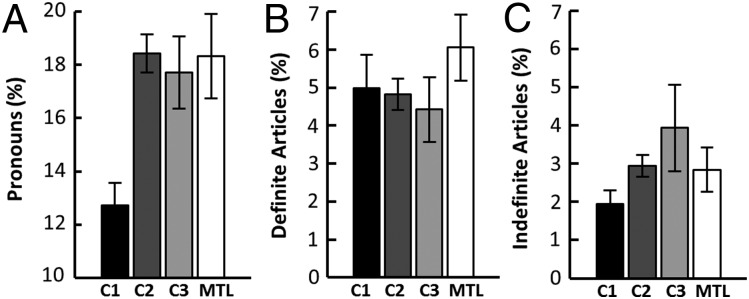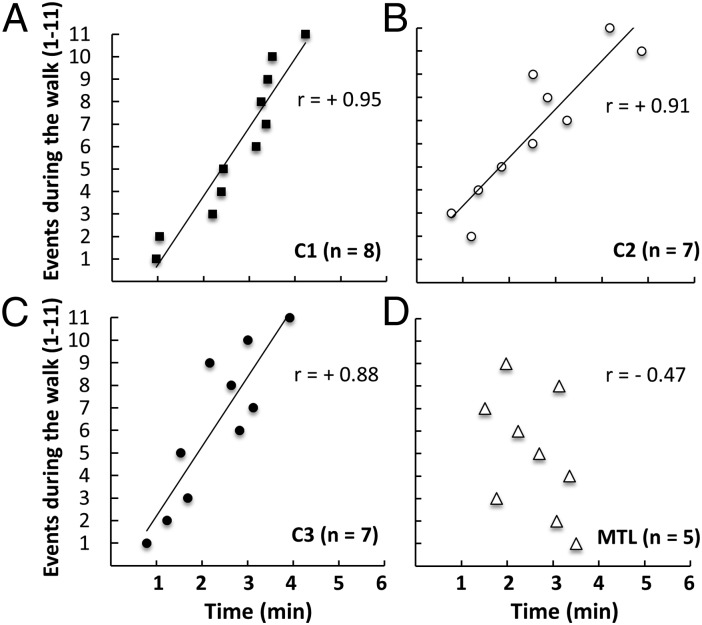Significance
When memory-impaired patients with medial temporal lobe (MTL) damage recollected the events of a guided walk, their memory was not only impoverished and lacking in detail but was also characterized by peculiarities in language use. However, as time passed after learning (up to 2.6 years), the recollections of healthy volunteers came to exhibit many of the same features with respect to both the richness of memory and language use. Thus, the characteristics of patient recollections appeared as a consequence of weak memory. The patients differed markedly from controls tested after long delays in that they reported events of the walk in a haphazard order. The results illuminate the nature of memory impairment and the function of the MTL.
Keywords: hippocampus, language, forgetting, autobiographical memory
Abstract
We studied the narrative recollections of memory-impaired patients with medial temporal lobe (MTL) damage who took a 25-min guided walk during which 11 planned events occurred. The recollections of the patients, recorded directly after the walk, were compared with the recollections of controls tested directly after the walk (C1), after one month (C2), or after 2.6 years (C3). With respect to memory for the walk, the narrative recollections of the patients were impoverished compared with C1 but resembled the recollections of volunteers tested after long delays (C2 and C3). In addition, how language was used by the patients in their recollections resembled how language was used by groups C2 and C3 (higher-frequency words, less concrete words, fewer nouns, more adverbs, more pronouns, and more indefinite articles). These findings appear to reflect how individuals, either memory-impaired patients or controls, typically speak about the past when memory is weak and lacks detail and need not have special implications about language use and MTL function beyond the domain of memory. A notable exception to the similarity between patient narratives and the narratives of C2 and C3 was that the control groups reported the events of the walk in correct chronological order, whereas the order in which patients reported events bore no relationship to the order in which events occurred. We suggest that the MTL is especially important for accessing global information about events and the relationships among their elements.
The hippocampus is important for the formation of declarative memory (1–3). In humans, bilateral damage to the hippocampus is associated with moderately severe anterograde amnesia and temporally limited retrograde amnesia (4). When damage extends into the adjacent cortical regions that lie along the parahippocampal gyrus, the memory impairment is more severe, as in the well-studied patients H.M. and E.P. (5, 6). In many respects, the memory performance of hippocampal patients resembles the performance of healthy individuals whose memories are weak as the result of being tested after long retention intervals (7). The memory impairment is circumscribed and occurs against a background of intact performance in a variety of perceptual and cognitive tasks: visual discrimination among stimuli with a high degree of feature overlap (8, 9), spatial perception (10–13), spatial imagery (14), map reading and navigation (15, 16), and semantic knowledge (e.g., long-established knowledge about the identity and function of common objects) (17).
Patients with hippocampal damage also succeed at tests of language function. They detected and explained linguistic ambiguity in sentences as well as controls (18), and they obtained normal scores for grammar and form in their spoken narratives (17). However, other studies have described situations where hippocampal patients use language differently than healthy volunteers (19). For example, hippocampal patients have been reported to use fewer definite articles in their discourse (20), higher-frequency words, and words with lower imageability (21) and to exhibit poorer narrative coherence (i.e., poorer continuity and organization in narratives) (22, 23). These irregularities in the use of language could reflect impaired cognitive functions other than memory that are supported by the hippocampus. Alternatively, they could reflect how narratives typically come to be constructed when memory is weak and has lost detail, whether in memory-impaired patients or in healthy individuals tested after a long retention interval.
Early studies by Bartlett (24) described how memories become impoverished and fragmented over time. This work involved retention intervals as long as 10 y, although it was based largely on single subjects and qualitative accounts of recollection. Using Bartlett’s original material (the “War of the Ghosts” story), Bergman and Roediger (25) replicated the earlier work, documenting omissions, intrusions, and distortions across an interval of 6 mo. Studies of “flashbulb memories” (i.e., memories of surprising and shocking events) have also described loss of detail and inaccuracy across intervals up to 3 y (26, 27). Across time, verbatim recall is often replaced by memory for the gist of what happened, and even the gist can be forgotten (28, 29). While these studies document the amount of forgetting and reorganization that can occur across long time periods, there have been few, if any, studies of how language itself changes as memory is tested at different times after learning.
We have examined the narrative recollections of memory-impaired patients with medial temporal lobe lesions (the MTL group) who took a guided 25-min walk during which 11 planned events occurred (Fig. 1). The MTL group had lesions limited to the hippocampus (n = 4) or larger MTL lesions (n = 1). We compared the recollections of the patients to the recollections of volunteers tested as long as 2.6 y after the walk. We first examined the accuracy of the recollections, the number of details that described episodic memories about the events of the walk, and the richness of these details. Next, we counted the number of words used to report the details and examined several characteristics of the content words (nouns, adjectives, verbs, adverbs): their frequency, concreteness, and imageability. We also calculated the percentage of each type of content word, as well as the percentage of pronouns, definite articles, and indefinite articles among the words and phrases used to report the details. We also examined the temporal order in which the events of the walk were reported and the coherence of the narratives. In this way, we asked how the narrative recollections of the patients resembled and differed from the narratives of healthy volunteers tested after long delays.
Fig. 1.
Map indicating where 11 planned events occurred during a 25-min guided walk: 1: Discard cup. 2: Find change in vending machine. 3: View portraits. 4: Point out coffee cart. 5: Find book in library. 6: Receive bike lock. 7: Lock bike. 8: View statue. 9: Buy banana. 10: Tie shoes. 11: Drink from fountain. Sidewalks are light gray. Buildings are dark gray. Arrows indicate the path taken during the walk. Also see Materials and Methods. Reprinted from ref. 30.
Results
Events Remembered.
Memory for the events of the walk declined as time passed. Fig. 2A shows the number of events referred to during the 6-min narratives (8.8, 8.0, and 5.7 events for C1, C2, and C3, respectively). Fig. 2B shows the scores on a 40-item, two-alternative test about the events of the walk (84.4, 73.6, 66.1% correct). For both measures, C3 (tested 2.6 y after the walk) performed more poorly than C1 (tested directly after the walk) (t[6] > 3.4, P < 0.02). Note, however, that even 2.6 y after the walk, participants remembered a good deal of material. For example, the 66.1% correct score on the 40-question test by C3 was well above the 46.8% score obtained by participants who took the same test without having taken the walk (t[15] = 5.1, P < 0.001). Fig. 2 also shows that the MTL group (tested directly after the walk) performed worse on both tests than C1 (6.6 in Fig. 2A; 65.0% in Fig. 2B; t[11] > 2.9, P < 0.02; t test for unequal variance) but similarly to the C2 and C3 groups tested after delays (t[10] < 1.7, P > 0.10).
Fig. 2.
Mean number of events referred to by each group during 6-min narrative recollections about the walk (A). Performance on 40 two-alternative, forced-choice questions about the events of the walk (B). C1 (n = 8), controls tested directly after the walk. C2 (n = 7), controls tested 1 mo after the walk. C3 (n = 7), controls from the C1 group tested 2.6 y after the walk. MTL (n = 5), patients with medial temporal lobe lesions.
Words Spoken and Details Recollected.
The groups also spoke fewer total words during their 6-min narratives as time passed (574.3, 492.6, and 435.9 words for C1, C2, and C3, respectively; C1 vs. C3, t[6] = 2.59, P < 0.05). Again, the MTL group (489.6 words) spoke about as many words as the C2 and C3 groups tested after delays (t[10] < 0.60, P > 0.10). The groups differed even more with respect to how many words in the narratives actually described events from the walk (i.e., episodic details). Fig. 3A shows that for C1, 442.5 words (78% of the total) were in the service of describing episodes from the walk, whereas the number was only 277.0 for C2 (59% of total), 180.0 for C3 (40% of total), and 182.6 for MTL (42% of total) (C1 vs. C3, t[6] = 4.97, P < 0.01; MTL vs. C2 and C3, t[10] < 2.1, P > 0.10; MTL vs. C1, t[8] = 5.43, P < 0.001; t test for unequal variance). Thus, the participants in the C1 group, tested directly after the walk, used more words in their 6-min narratives to describe episodes from the walk than did the other groups. In addition, their narratives were efficient in that most of their words were used to describe episodes. The other groups used fewer words to describe episodes from the walk and their narratives were inefficient. Many of the words were parts of repetitions, bits of semantic details, and irrelevant comments.
Fig. 3.
Mean number of words in the 6-min narrative recollections used to report accurate episodic details about the walk (A). Mean number of accurate episodic details about the walk reported by each group in the 6-min narrative recollections (B). Groups are as in Fig. 2.
Consistent with these differences in the number of words spoken, the groups differed markedly in how many accurate episodic details they reported (Fig. 3B). C1 reported 56 details, considerably more than the 20 details reported by C3 (t[6] = 6.43, P < 0.001). The MTL group recollected 24 details, fewer than C1 (t[11] = 4.42, P < 0.001) but similar to the number of details recollected by C2 (32 details) and C3 (20 details) (MTL vs. C2 and C3, t[10] < 1.25, P > 0.10). The following analyses were based on the words that appeared in the sentences and phrases that described these episodic details.
Richness of Episodic Detail.
Given that the number of details available about the events of the walk declined with the passage of time, it is not surprising that the quality of the recollections also declined. The richness score (Fig. 4) is intended to indicate the episodic quality of the recollections that were produced about each event. Across events, the mean richness score (0–6) of the sentences and phrases describing episodic details was 4.05, 3.67, and 3.34 for C1, C2, and C3, respectively (C1 vs. C3, t[6] = 2.78, P < 0.05). The score for the MTL group (3.10) was lower than the scores for C1 and C2 (t > 2.7, P < 0.05) but similar to the C3 score (t[10] = 1.04, P > 0.10).
Fig. 4.
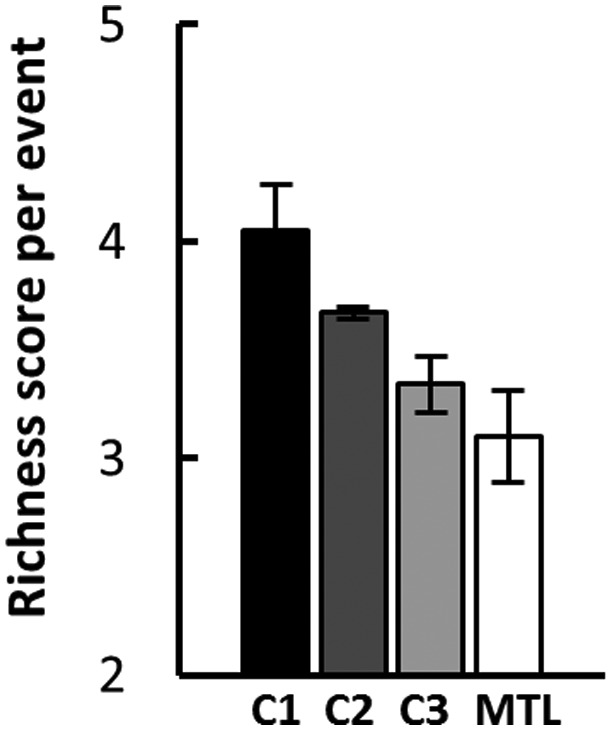
Mean richness of the episodic details describing each event in 6-min narrative recollections about the walk. Richness was rated on a 0–6 scale (see Materials and Methods). Groups are as in Fig. 2.
Properties of Content Words.
We next examined the content words (nouns, adjectives, verbs, and adverbs) that appeared within the sentences and phrases that described episodic details. Fig. 5 shows scores for word frequency and ratings for the concreteness and imageability of the content words. As time passed after the walk, participants used higher-frequency words (Fig. 5A), less concrete words (Fig. 5B), and less imageable words (Fig. 5C). For word frequency (Fig. 5A), the scores were 162, 203, and 287 for C1, C2, and C3, respectively (C1 vs. C2, t[13] = 2.37, P < 0.05; C1 vs. C3, t[6] = 7.72, P < 0.001).
Fig. 5.
Characteristics of the content words (nouns, adjectives, verbs, adverbs) used to report accurate episodic details in the 6-min narrative recollections about the walk. (A) Word frequency of the content words. (B) Concreteness of the words. (C) Imageability of the words. Word frequency is based on a corpus of 190,000 words. Concreteness and imageability are based on ratings (100–700); see Materials and Methods. Groups are as in Fig. 2.
The word frequency score for the MTL group (260) was similar to the scores obtained by the control groups tested after delays. Thus, the frequency of words used by the MTL group was higher than that of C1 (t[11] = 4.47, P < 0.001), marginally higher than that of C2 (t[10] = 2.14, P < 0.06), and most similar to that of C3 (t[10] = 0.86, P > 0.10). For concreteness (Fig. 5B), the ratings were 428, 410, and 394 for C1, C2, and C3, respectively (C1 vs. C2, t[13] = 2.13, P < 0.09; C1 vs. C3, t[6] = 3.72, P < 0.01). The concreteness rating for the MTL group (414) was most similar to that of the control groups tested after delays (C2 and C3 vs. MTL, t[10] < 1.80, P > 0.10). However, the MTL rating in this case did not differ significantly from that of C1 (t[11] = 1.32, P > 0.10). For imageability (Fig. 5C), the ratings were 443, 432, and 415 for C1, C2, and C3, respectively (C1 vs. C2, t[13] = 1.93, P < 0.08; C1 vs. C3, t[6] = 3.68, P < 0.01). The imageability rating for the MTL group (441) was marginally higher than that of C3 (t[10] = 2.18, P = 0.054) and not measurably different from those of the other groups (t < 0.99, P > 0.34).
Across groups, nouns accounted for 38.1% of the content words used to describe episodic details, verbs accounted for 25.5%, adverbs accounted for 18.8%, and adjectives accounted for 17.5%. As time passed after the walk, the use of nouns and adverbs changed (Fig. 6), but there were not systematic changes in the use of verbs or adjectives. Specifically, nouns appeared less frequently in the narratives as time passed, and adverbs appeared more frequently. The percentage of nouns was 41.8, 36.0, 38.3, and 36.6 for C1, C2, C3, and MTL, respectively (C1 vs. C2, t[13] = 2.64, P < 0.05; C1 vs. C3, t[6] = 2.37, P < 0.06). The MTL group used nouns at about the same frequency as the groups tested after delays (t < 0.5, P > 0.65), although not significantly less frequently than C1 (t[11] = 1.60, P = 0.14). For adverbs, the percentages were 16.6, 17.6, 22.1, and 18.9 (C1 vs. C3, t[6] = 4.00, P < 0.01; C2 vs. C3, t[12] = 2.28, P < 0.05). The MTL group used adverbs at about the same frequency as the groups tested after delays (t < 1.5, P > 0.16) and more frequently than C1 (t[11] = 2.27, P < 0.05). For verbs, the percentages were 24.0, 30.4, 25.2, and 22.5. For adjectives, the percentages were 17.6, 16.0, 14.5, and 22.1.
Fig. 6.
Percentage of nouns among the words used to report accurate episodic details in the 6-min narrative recollections about the walk (A). Percentage of adverbs used to report accurate episodic details in the 6-min narrative recollections about the walk (B). Groups are as in Fig. 2.
Pronouns.
Fig. 7A shows the percentage of pronouns that appeared among the words in the sentences and phrases that described episodic details. The percentages were 12.7, 18.4, 17.7, and 18.3 for C1, C2, C3, and MTL, respectively. C1, tested directly after the walk, used about 30% fewer pronouns than the MTL group or the groups tested after delays (t > 3.4, P < 0.001). The MTL group, C2, and C3 used pronouns with similar frequency.
Fig. 7.
Percentage of pronouns among the words used to report accurate episodic details in the 6-min narrative recollections (A). Percentage of definite articles used to report episodic details (B). Percentage of indefinite articles used to report episodic details (C). Groups are as in Fig. 2.
Articles.
We next examined the percentage of definite (the) and indefinite (a, an) articles that appeared among the words in the sentences and phrases that described episodic details. For definite articles (Fig. 7B), the percentages tended to decrease as time passed after the walk (5.0, 4.8, 4.4, and 6.1 for C1, C2, C3, and MTL, respectively). For indefinite articles (Fig. 7C), the percentages tended to increase (2.0, 2.9, 3.9, and 2.8) (C1 vs. C2, t[13] = 2.11, P < 0.054; C1 vs. C3, t[6] = 2.28, P < 0.063). We considered the possibility that these trends represent a meaningful feature of normal forgetting. Thus, one might suppose that, as time passes after a learning event, the word “a” or “an” might often substitute for “the” as memory becomes less precise. For example, one might initially say “I remember the library” but later say “I remember a library.” We found some support for this idea in a two-way, repeated measures ANOVA, where one factor was time (C1 tested directly after the walk vs. C3 tested 2.6 y after the walk) and the other factor was article type (definite vs. indefinite). The ANOVA yielded an effect of article type (F[1,12] = 6.23, P < 0.05) and, notably, a marginal interaction of time × article type (F[1,12] = 3.42, P = 0.09). The MTL group, like the other groups, used fewer indefinite articles than definite articles, but the scores of the MTL group did not differ significantly from the scores of any other group (t < 1.38, P > 0.19).
Temporal Order of Event Memory.
Fig. 8 shows when each event of the walk was mentioned during the course of the 6-min narrative recollections. Note that the number of events mentioned varied from group to group (Fig. 2A), and only one participant (in C1) referred to all of the events. As reported previously (30), the C1 and C2 groups described events approximately in the order that the events occurred (Fig. 8 A and B). In contrast, the order in which the MTL group described events (Fig. 8D) was unrelated to the order in which the events occurred. In the present study, we found that even participants tested 2.6 y after the walk (C3) described events close to the order in which they had occurred (Fig. 8C). Indeed, C3 related events in the proper order despite the fact that this group referred to fewer events in their narratives than did the MTL group (5.7 vs. 6.6, Fig. 2A) and remembered fewer details (20 vs. 24 details, Fig. 3B).
Fig. 8.
The data points show when, on average, the events from the walk were referred to during the 6-min narratives. The control groups tended to describe events in the order that they occurred (A–C). The order in which the MTL patients mentioned events was unrelated to the order in which the events occurred (D). Lines represent significant fits to the data. No C2 described event 1. No C3 described event 4. No patient described events 10 and 11.
Narrative Coherence.
Fig. 9 shows the coherence score for the 6-min narratives based on ratings of how well a narrative was oriented in space and time (context), the extent to which actions were reported in a sensible order (chronology), and the extent to which participants remained on topic and told a coherent story (theme). The overall coherence score declined with the passage of time after the walk (2.13, 1.86, and 1.74 for C1, C2, and C3, respectively; C1 vs. C3, t[6] = 3.672, P = 0.01). This change in coherence score was due largely to the change in chronology scores as time passed (2.69, 2.14, and 2.07 for C1, C2, and C3, respectively; C1 vs. C3, t[6] = 3.667, P = 0.01). The scores for context were low because of the few references to time and were virtually the same across the three control groups (1.13, 1.00, 1.07). The scores for theme declined a little with time (2.56, 2.43, 2.07), but the difference between groups did not reach significance (C1 vs. C3, t[6] = 1.99, P = 0.09). Note that the theme score would be affected by a poor chronology score because a lack of temporal order affects the ability to tell a coherent story that stays on topic and provides an ending.
Fig. 9.
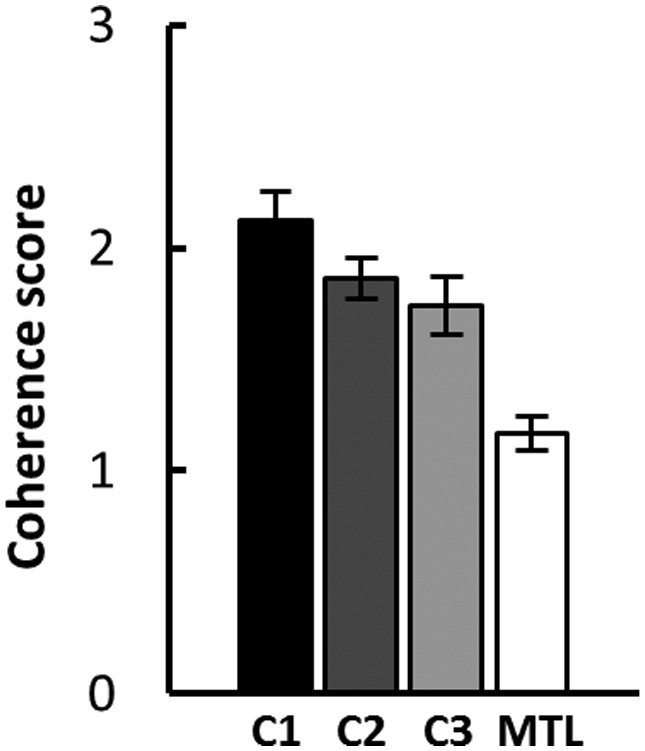
Coherence of the 6-min narrative recollections based on ratings (0–3) for each of three characteristics of the narratives: context, chronology, and theme (see Materials and Methods). Groups are as in Fig. 2.
The MTL group obtained a coherence score much lower than the other groups (MTL vs. each control group, t > 3.39, P < 0.01). This finding was due largely to the poor chronology score for the MTL group (0.80; MTL vs. each control group, t > 3.43, P < 0.01). The MTL group obtained the same score as the other groups on the context measure (1.00). The MTL score for theme (1.70) was also low, although not measurably different from the score of any control group (t < 1.42, P > 0.17).
Discussion
Healthy volunteers and memory-impaired patients recollected the events of a 25-min guided walk. They first generated 6-min narratives about the walk and then answered 40 questions. The patients were tested directly after the walk (MTL group). The volunteers were tested either directly after the walk (C1) or 1 mo after the walk (C2). In addition, seven of the eight participants in C1 were tested again 2.6 y after the walk (C3). As time passed after the walk, memory for the events of the walk weakened. The volunteers remembered fewer events (Fig. 2A), answered fewer questions about the walk correctly (Fig. 2B), spoke fewer words overall and fewer words that specifically described events (Fig. 3A), recalled fewer details about the walk (Fig. 3B), and generated narratives with lower richness scores (Fig. 4). We note that group C3, tested after 2.6 y, likely benefited from having also received the initial test (see ref. 25 for such a benefit of repeated testing). Still, C3 consistently performed more poorly than group C2.
The passage of time also affected the way in which words were used in the narratives as well as the organization of the narratives. Among the content words (nouns, adjectives, verbs, adverbs), volunteers used higher-frequency (i.e., more common) words as time passed (Fig. 5A), less concrete words (Fig. 5B), less imageable words (Fig. 5C), fewer nouns (Fig. 6A), and more adverbs (Fig. 6B). They also used more pronouns (Fig. 7A) and tended to use indefinite articles in favor of definite articles (Fig. 7 B and C). All of the volunteers reported events close to the order in which the events occurred, even 2.6 y after the walk (Fig. 8 A–C), with small decreases in temporal precision across time (r = 0.95, r = 0.91, r = 0.88). Last, estimates of narrative coherence declined with time (Fig. 9). This score depends importantly on the ability to report events in proper temporal order, and across participants, it also correlated with estimates of richness (r = 0.56, P < 0.01). These findings, taken together, describe an effect of time on memory that resulted in briefer narratives that were less precise and lacked detail.
Patients in the MTL group also generated narratives that were imprecise and lacked detail. With respect to the content of memory (number of events referred to, number of questions answered correctly, number of words used, number of details recalled, and the richness of the narratives), the MTL group differed sharply from the C1 group and resembled the C3 group tested after 2.6 y (Figs. 2–4). With respect to language use, the MTL group also obtained scores similar to the scores of the volunteers tested after delays. Thus, the MTL group tended to use high-frequency words (Fig. 5A), less concrete words (Fig. 5B), fewer nouns (Fig. 6A), more adverbs (Fig. 6B), more pronouns (Fig. 7A), and more indefinite articles (Fig. 7C). Two clear exceptions to this pattern were that the MTL group was intact (and similar to C1) with respect to the imageability of the words in their narratives (Fig. 5C) and with respect to the use of definite articles (Fig. 7B).
The most striking finding in the narratives of the MTL patients was that the events of the walk were reported in a haphazard order that bore no relationship to the order in which the events actually occurred (Fig. 8D). Indeed, the MTL group performed far more poorly than even volunteers in group C3 tested after 2.6 y (Fig. 8C). In earlier work (30), we noted the poor temporal order memory of MTL patients in comparison with volunteers tested after a delay of 1 mo (C2). However, in that case, the MTL group also had marginally poorer fact memory than the C2 group (Figs. 2 and 3B). It therefore seemed possible that the temporal structure of narratives generated by volunteers might collapse at some longer interval after the walk, perhaps at a time when the fact memory of volunteers was as poor as the fact memory of the MTL group. However, this did not occur. The C3 group tested 2.6 y after the walk had good temporal order memory, far better than the MTL group, although fact memory for the walk itself was a little worse than in the MTL group (Figs. 2A and 3B). We suppose that the poor narrative coherence score obtained by the MTL group (Fig. 9) reflects this same difficulty in appreciating temporal order.
The fact that the passage of time affected the use of language in narrative recollections is relevant to earlier studies describing abnormalities in language use by memory-impaired patients with hippocampal lesions. For example, reports that patients used fewer definite articles (20), higher-frequency words (21), and words with lower imageability (21) may reflect how patients typically speak when memory is weak and lacks detail. This idea was proposed by the earlier authors, and the present findings support it by showing directly that the use of language by memory-impaired patients matched in many respects the use of language by volunteers whose memory was weak as a result of being tested after a long delay. The same explanation may apply as well to other reports of unusual language use in patients with hippocampal lesions, including reductions in the use of “reported speech” in discourse (i.e., direct or indirect quotes that represent a different context) (31), verbal play during conversation (32), the use of gestures during explanatory prose (33), and difficulty interpreting pronouns based on information presented earlier in a short passage (34). These findings may describe characteristics of language use that can appear whenever memory is weak and impoverished because in that circumstance it is difficult to import material from other sources, to recall earlier parts of conversations or passages, and to remember content with enough vividness to support gestures. If so, such findings need not imply additional functions of the hippocampus beyond the domain of memory.
Note that our findings differed in two respects from what was reported in these earlier studies. In the earlier work, patients used fewer definite articles than controls (20) and words with lower imageability (21), but our patients did not (Figs. 5C and 7B). These different findings may reflect differences in the methods used across studies to collect narrative material (scoring recollections of a structured walk in our study vs. scoring conversations or narratives generated in response to a cue word).
In our study, the MTL group obtained low scores for narrative coherence, presumably due to the importance of temporal order information for our measure of coherence. Other groups have also developed measures of narrative coherence using different methods (22, 23, 35). In one study, memory-impaired patients generated narratives about the past or future in response to prompts about events or generated narratives that told a story about detailed drawings of scenes (23). The narratives of the patients were described as lacking overall continuity and organization. Another study found poor coherence in the narratives of patients as they described how to carry out specific procedures, for example, changing a tire (22). A third study asked patients to tell a story as they paged through 24 illustrations from a children’s book (35). The patients obtained good scores for coherence in this case, perhaps because seeing the story unfold in sequence provided helpful structure and a basis for organizing a narrative.
The impairments in temporal order and narrative coherence that we found (Figs. 8 and 9) emerged in the course of a memory test, whereas the deficit in narrative coherence reported in these other studies (22, 23) emerged not from conventional memory tests but from tests that asked participants to generate narratives (e.g., about events, scenes, or procedures). Nevertheless, it seems reasonable to suppose that memory is also important in tasks of this type—for remembering information that exceeds working memory capacity, for combining information creatively, and for remembering at any point what one has said so far.
Difficulty in organizing narratives into proper temporal order may have made an especially important contribution to the impairment in narrative organization identified in the earlier studies (22, 23), just as we suppose that the ability to construct narratives in a sensible temporal order contributed to our measure of narrative coherence (Fig. 9). This difficulty need not imply a selective impairment in temporal order information. Instead, difficulty in narrative construction may rest on a broader impairment in the ability to assess global information about events, scenes, or stories and the relationships among their elements, especially elements separated in time, regardless of whether the relationships are temporal, spatial, or perceptual. Others have also discussed the importance of learning about relationships (relational knowledge) for understanding the role of the hippocampus and MTL structures (36, 37).
Materials and Methods
In an earlier study, five patients with MTL damage and healthy volunteers took a guided 25-min walk during which 11 planned events occurred (Fig. 1) (30). The events were enacted by the guide (e.g., discard cup) or with a collaborator (sixth event, receive bike lock). The volunteers were tested for what they could remember either directly after the walk (C1, n = 8), like the patients (MTL), or were tested after a delay of 1 mo (C2, n = 7). The present study was based on the narrative recollections that participants generated in those memory tests and on new data from volunteers in the earlier study who had been tested directly after the walk and were tested again 2.6 y after the walk (range = 2.5–2.7 y) (C3, n = 7). Thus, we explored the characteristics of narrative construction in memory-impaired patients and in healthy individuals whose memory had been weakened by the passage of time. Magnetic resonance images and information about the patients appear in SI Appendix. All procedures were approved by the Institutional Review Board at the University of California, San Diego, and participants gave written informed consent before participation.
The Walk and the Memory Tests.
Participants were told that their memory would be tested for everything that occurred during the walk (except conversation). Participants were given up to 6 min to describe in detail what they could remember. Next, they received a prompt for each of the 11 events and then had up to 1 min to describe the event in detail. This test will not be considered further. Last, participants were asked 40 two-alternative, forced-choice questions about the 11 events. A separate group of volunteers who did not take the walk was given only the two-alternative, forced-choice test to determine chance-level performance (n = 10; 6 female; mean age = 55.2 y; mean education = 14.6 y). They scored 46.8 ± 2.2% correct.
Events Remembered and Details Recollected.
Using methods outlined previously, we counted the number of accurate details in the 6-min narratives that described aspects of specific events (episodic details) (38–41). Details were not scored if they were inaccurate, that is, did not describe something that occurred on the walk, or if they were unverifiable.
To ensure that our counting of accurate episodic details for the new data from C3 was consistent with the counting of details done previously (30), the 6-min narratives from a total of four C1 and C2 participants were rescored and compared with the earlier scores reported for these two groups. Across participants, the correlation between the two sets of scores was 0.98. The number of accurate episodic details in the C3 narratives was then counted by N.C.H. A second person also scored all of the transcripts (correlation between raters across participants = 0.98).
Number of Words.
We counted the total number of words used in the 6-min narratives as well as the number of words that appeared within the sentences or phrases that contained accurate episodic details.
Richness of Episodic Detail.
Each event reported in the 6-min narratives received a score (0–6) based on the richness of the episodic details used to describe that event. The richness score was based on methods developed by Levine et al. (39) and was intended to indicate “the overall degree to which a feeling of reexperiencing was conveyed.” The highest scores (5 or 6) were assigned to events described in rich and specific detail, which appeared to be based on a feeling of reexperiencing. The lowest scores (1 or 2) were assigned to events described in limited detail and with little specific information about the event itself. Intermediate scores (3 or 4) were assigned to events described in moderate detail that included at least two related pieces of information. The scores assigned to each event were averaged to obtain a richness score for each participant. Scoring of richness was based on the average score of two raters (correlation across participants between the two sets of scores = 0.89). All scoring, here and elsewhere, was done blind to group membership.
Properties of Content Words.
For the 6-min narratives, we next examined the properties of the content words (nouns, adjectives, verbs, adverbs) that appeared in the sentences or phrases that contained episodic details. Proper nouns were not included. We first calculated the number of each type of content word. To take into account the fact that the groups differed in how many words were used, we divided the number of nouns, adjectives, verbs, and adverbs used by each participant by the total number of words that each participant used to report episodic details. Next, using the MRC Psycholinguistic Database (websites.psychology.uwa.edu.au/school/MRCDataBase/uwa_mrc.htm), we obtained measures for word frequency, concreteness, and imageability for each unique content word. The content words were then combined to obtain an average measure of frequency, concreteness, and imageability for each participant. The database provided ratings for 67.8% of the content words in the narratives. Word frequency was the frequency with which words appeared in a corpus of ∼190,000 words of spoken English (42). Estimates of both concreteness and imageability are based on ratings (100–700) [see Coltheart (43)].
Pronouns.
We next counted within the 6-min narratives the number of pronouns that appeared among the words in the sentences and phrases that described episodic details. As with content words, we divided the number of pronouns used by each participant by the total number of words used to report episodic details. Most pronouns were self-referential (41.8%: I, me, we, us, our) or referenced others (35.9%: he, she, it, him, her, they, them). The others (22.3%) were possessive (mine, yours, his, hers, its, ours, theirs), reflexive (myself, herself, ourselves, itself), relative (that, which, who, whom, what, whose), or indefinite (everybody, either, none, something).
Definite and Indefinite Articles.
We also recorded within the 6-min narratives the number of articles that appeared within the sentences and phrases containing accurate episodic details. All definite (the) and indefinite (a, an) articles were counted. As with content words, the number of articles used by each participant was divided by the total number of words that each participant used to report episodic details.
Temporal Order of Event Memory.
We used the audio recordings to note the time during the 6-min narratives when participants in C3 mentioned each event. The same data were presented previously for C1, C2, and the MTL patients (30) and are presented here as well. For events mentioned more than once, the times when the event was mentioned were averaged. In this way, we calculated the order in which events were reported.
Narrative Coherence.
Narrative coherence is a measure of the quality of autobiographical memories (44) and was used in a recent study of memory-impaired patients (23). As in that study, we scored narrative coherence as a composite of three separate factors: context, chronology, and theme. Context refers to the extent to which a narrative was oriented in space and time. Chronology refers to the extent to which the actions in a narrative were reported in a sensible temporal order. Theme refers to the extent to which participants remained on topic, reported details that were causally related to each other, and provided a resolution to the story. For each 6-min narrative, the sentences and phrases that contained episodic details provided the basis for a single score (0, 1, 2, or 3) on each of the three dimensions (context, chronology, and theme). The three scores were then averaged and averaged again across two raters to obtain a single coherence score for each participant (correlation across participants between the single scores of the two raters = 0.86). We expected measures of chronology, and to some extent theme, to overlap with our measure of temporal order of event memory. In addition, we expected the context measure to be influenced by the particular circumstances of the present study. Participants were instructed to remember a walk, so there should be ample references to places. However, because the narratives were directed to the experimenter, who had shared the walk, one might expect fewer references to time.
Data Analysis.
To determine how healthy volunteers performed as time passed after the walk, we relied primarily on comparisons by paired t tests between the scores of seven (out of eight) participants in C1 and the same seven participants when they were tested again 2.6 y after the walk (C3). The fact that C1 and C3 involved the same individuals and C2 involved different individuals ruled out the use of ANOVAs and trend analyses that could have included all three groups (C1, C2, and C3). We compared the MTL patients to the control groups using two-sample t tests. In all figures, error bars denote SEM.
Supplementary Material
Acknowledgments
We thank J. Frascino, C. Rivera, and A. Dede for assistance and C. N. Smith for helpful comments. This work was supported by the Medical Research Service of the Department of Veterans Affairs (51K6CX001644), Award CX000359, and NIMH Grant 24600.
Footnotes
The authors declare no conflict of interest.
This article contains supporting information online at www.pnas.org/lookup/suppl/doi:10.1073/pnas.1820765116/-/DCSupplemental.
References
- 1.Squire LR. Memory and the hippocampus: A synthesis from findings with rats, monkeys, and humans. Psychol Rev. 1992;99:195–231. doi: 10.1037/0033-295x.99.2.195. [DOI] [PubMed] [Google Scholar]
- 2.Gabrieli JDE. Cognitive neuroscience of human memory. Annu Rev Psychol. 1998;49:87–115. doi: 10.1146/annurev.psych.49.1.87. [DOI] [PubMed] [Google Scholar]
- 3.Eichenbaum H, Cohen NJ. From Conditioning to Conscious Recollection: Memory Systems of the Brain. Oxford Univ Press; New York: 2004. [Google Scholar]
- 4.Manns JR, Hopkins RO, Squire LR. Semantic memory and the human hippocampus. Neuron. 2003;38:127–133. doi: 10.1016/s0896-6273(03)00146-6. [DOI] [PubMed] [Google Scholar]
- 5.Milner B. Disorders of learning and memory after temporal lobe lesions in man. Clin Neurosurg. 1972;19:421–446. doi: 10.1093/neurosurgery/19.cn_suppl_1.421. [DOI] [PubMed] [Google Scholar]
- 6.Insausti R, Annese J, Amaral DG, Squire LR. Human amnesia and the medial temporal lobe illuminated by neuropsychological and neurohistological findings for patient E.P. Proc Natl Acad Sci USA. 2013;110:E1953–E1962. doi: 10.1073/pnas.1306244110. [DOI] [PMC free article] [PubMed] [Google Scholar]
- 7.Haist F, Shimamura AP, Squire LR. On the relationship between recall and recognition memory. J Exp Psychol Learn Mem Cogn. 1992;18:691–702. doi: 10.1037//0278-7393.18.4.691. [DOI] [PubMed] [Google Scholar]
- 8.Shrager Y, Gold JJ, Hopkins RO, Squire LR. Intact visual perception in memory-impaired patients with medial temporal lobe lesions. J Neurosci. 2006;26:2235–2240. doi: 10.1523/JNEUROSCI.4792-05.2006. [DOI] [PMC free article] [PubMed] [Google Scholar]
- 9.Kim S, et al. Memory, visual discrimination performance, and the human hippocampus. J Neurosci. 2011;31:2624–2629. doi: 10.1523/JNEUROSCI.5954-10.2011. [DOI] [PMC free article] [PubMed] [Google Scholar]
- 10.Kim S, Dede AJ, Hopkins RO, Squire LR. Memory, scene construction, and the human hippocampus. Proc Natl Acad Sci USA. 2015;112:4767–4772. doi: 10.1073/pnas.1503863112. [DOI] [PMC free article] [PubMed] [Google Scholar]
- 11.Urgolites ZJ, Hopkins RO, Squire LR. Medial temporal lobe and topographical memory. Proc Natl Acad Sci USA. 2017;114:8626–8630. doi: 10.1073/pnas.1708963114. [DOI] [PMC free article] [PubMed] [Google Scholar]
- 12.Urgolites ZJ, Levy DA, Hopkins RO, Squire LR. Spared perception of object geometry and object components after hippocampal damage. Learn Mem. 2018;25:330–334. doi: 10.1101/lm.047464.118. [DOI] [PMC free article] [PubMed] [Google Scholar]
- 13.Rungratsameetaweemana N, Squire LR. Preserved capacity for scene construction and shifts in perspective after hippocampal lesions. Learn Mem. 2018;25:347–351. doi: 10.1101/lm.047340.118. [DOI] [PMC free article] [PubMed] [Google Scholar]
- 14.Kim S, et al. Sparing of spatial mental imagery in patients with hippocampal lesions. Learn Mem. 2013;20:657–663. doi: 10.1101/lm.031633.113. [DOI] [PMC free article] [PubMed] [Google Scholar]
- 15.Kim S, Sapiurka M, Clark RE, Squire LR. Contrasting effects on path integration after hippocampal damage in humans and rats. Proc Natl Acad Sci USA. 2013;110:4732–4737. doi: 10.1073/pnas.1300869110. [DOI] [PMC free article] [PubMed] [Google Scholar]
- 16.Urgolites ZJ, Kim S, Hopkins RO, Squire LR. Map reading, navigating from maps, and the medial temporal lobe. Proc Natl Acad Sci USA. 2016;113:14289–14293. doi: 10.1073/pnas.1617786113. [DOI] [PMC free article] [PubMed] [Google Scholar]
- 17.Schmolck H, Kensinger EA, Corkin S, Squire LR. Semantic knowledge in patient H.M. and other patients with bilateral medial and lateral temporal lobe lesions. Hippocampus. 2002;12:520–533. doi: 10.1002/hipo.10039. [DOI] [PubMed] [Google Scholar]
- 18.Schmolck H, Stefanacci L, Squire LR. Detection and explanation of sentence ambiguity are unaffected by hippocampal lesions but are impaired by larger temporal lobe lesions. Hippocampus. 2000;10:759–770. doi: 10.1002/1098-1063(2000)10:6<759::AID-HIPO1013>3.0.CO;2-A. [DOI] [PubMed] [Google Scholar]
- 19.Duff MC, Brown-Schmidt S. Hippocampal contributions to language use and processing. In: Hannula DE, Duff MC, editors. The Hippocampus from Cells to Systems. Springer; Cham, Switzerland: 2017. pp. 503–536. [Google Scholar]
- 20.Duff MC, Gupta R, Hengst JA, Tranel D, Cohen NJ. The use of definite references signals declarative memory: Evidence from patients with hippocampal amnesia. Psychol Sci. 2011;22:666–673. doi: 10.1177/0956797611404897. [DOI] [PMC free article] [PubMed] [Google Scholar]
- 21.Hilverman C, Cook SW, Duff MC. The influence of the hippocampus and declarative memory on word use: Patients with amnesia use less imageable words. Neuropsychologia. 2017;106:179–186. doi: 10.1016/j.neuropsychologia.2017.09.028. [DOI] [PMC free article] [PubMed] [Google Scholar]
- 22.Kurczek J, Duff MC. Cohesion, coherence, and declarative memory: Discourse patterns in individuals with hippocampal amnesia. Aphasiology. 2011;25:700–712. doi: 10.1080/02687038.2010.537345. [DOI] [PMC free article] [PubMed] [Google Scholar]
- 23.Race E, Keane MM, Verfaellie M. Sharing mental simulations and stories: Hippocampal contributions to discourse integration. Cortex. 2015;63:271–281. doi: 10.1016/j.cortex.2014.09.004. [DOI] [PMC free article] [PubMed] [Google Scholar]
- 24.Bartlett FC. Remembering: A Study in Experimental and Social Psychology. Cambridge Univ Press; Cambridge, UK: 1932. [Google Scholar]
- 25.Bergman ET, Roediger HL., III Can Bartlett’s repeated reproduction experiments be replicated? Mem Cognit. 1999;27:937–947. doi: 10.3758/bf03201224. [DOI] [PubMed] [Google Scholar]
- 26.Neisser U, Harsch N. Phantom flashbulbs: False recollections of hearing the news about Challenger. In: Winograd E, Neisser U, editors. Affect and Accuracy in Recall: Studies of Flashbulb Memories. Cambridge Univ Press; Cambridge, UK: 1992. pp. 9–31. [Google Scholar]
- 27.Schmolck H, Buffalo EA, Squire LR. Memory distortions develop over time: Recollections of the O.J. Simpson trial verdict after 15 and 32 months. Psychol Sci. 2000;11:39–45. doi: 10.1111/1467-9280.00212. [DOI] [PubMed] [Google Scholar]
- 28.Neisser U. John Dean’s memory: A case study. Cognition. 1981;9:1–22. doi: 10.1016/0010-0277(81)90011-1. [DOI] [PubMed] [Google Scholar]
- 29.Brainerd CJ, Reyna VF. Fuzzy-trace theory and false memory. Curr Dir Psychol Sci. 2002;11:164–169. [Google Scholar]
- 30.Dede AJ, Frascino JC, Wixted JT, Squire LR. Learning and remembering real-world events after medial temporal lobe damage. Proc Natl Acad Sci USA. 2016;113:13480–13485. doi: 10.1073/pnas.1617025113. [DOI] [PMC free article] [PubMed] [Google Scholar]
- 31.Duff MC, Hengst JA, Tranel D, Cohen NJ. Talking across time: Using reported speech as a communicative resource in amnesia. Aphasiology. 2007;21:702716. doi: 10.1080/02687030701192265. [DOI] [PMC free article] [PubMed] [Google Scholar]
- 32.Duff MC, Hengst JA, Tranel D, Cohen NJ. Hippocampal amnesia disrupts verbal play and the creative use of language in social interaction. Aphasiology. 2009;23:926–939. doi: 10.1080/02687030802533748. [DOI] [PMC free article] [PubMed] [Google Scholar]
- 33.Hilverman C, Cook SW, Duff MC. Hippocampal declarative memory supports gesture production: Evidence from amnesia. Cortex. 2016;85:25–36. doi: 10.1016/j.cortex.2016.09.015. [DOI] [PMC free article] [PubMed] [Google Scholar]
- 34.Kurczek J, Brown-Schmidt S, Duff M. Hippocampal contributions to language: Evidence of referential processing deficits in amnesia. J Exp Psychol Gen. 2013;142:1346–1354. doi: 10.1037/a0034026. [DOI] [PMC free article] [PubMed] [Google Scholar]
- 35.Keven N, Kurczek J, Rosenbaum RS, Craver CF. Narrative construction is intact in episodic amnesia. Neuropsychologia. 2018;110:104–112. doi: 10.1016/j.neuropsychologia.2017.07.028. [DOI] [PubMed] [Google Scholar]
- 36.Eichenbaum H, Cohen NJ, Otto T, Wible C. Memory representation in the hippocampus: Functional domain and functional organization. In: Squire LR, Lynch G, Weinberger NL, McGaugh JL, editors. Memory: Organization and Locus of Change. Academic; New York: 1991. pp. 163–204. [Google Scholar]
- 37.Konkel A, Cohen NJ. Relational memory and the hippocampus: Representations and methods. Front Neurosci. 2009;3:166–174. doi: 10.3389/neuro.01.023.2009. [DOI] [PMC free article] [PubMed] [Google Scholar]
- 38.Bayley PJ, Hopkins RO, Squire LR. Successful recollection of remote autobiographical memories by amnesic patients with medial temporal lobe lesions. Neuron. 2003;38:135–144. doi: 10.1016/s0896-6273(03)00156-9. [DOI] [PubMed] [Google Scholar]
- 39.Levine B, Svoboda E, Hay JF, Winocur G, Moscovitch M. Aging and autobiographical memory: Dissociating episodic from semantic retrieval. Psychol Aging. 2002;17:677–689. [PubMed] [Google Scholar]
- 40.Race E, Keane MM, Verfaellie M. Medial temporal lobe damage causes deficits in episodic memory and episodic future thinking not attributable to deficits in narrative construction. J Neurosci. 2011;31:10262–10269. doi: 10.1523/JNEUROSCI.1145-11.2011. [DOI] [PMC free article] [PubMed] [Google Scholar]
- 41.Dede AJ, Wixted JT, Hopkins RO, Squire LR. Autobiographical memory, future imagining, and the medial temporal lobe. Proc Natl Acad Sci USA. 2016;113:13474–13479. doi: 10.1073/pnas.1615864113. [DOI] [PMC free article] [PubMed] [Google Scholar]
- 42.Brown GDA. A frequency count of 190,000 words in the London-Lund Corpus of English conversation. Behav Res Methods Instrum Comput. 1984;16:502–532. [Google Scholar]
- 43.Coltheart M. The MRC Psycholinguistic Database. Q J Exp Psychol Sect A. 1981;33:497–505. [Google Scholar]
- 44.Reese E, et al. Coherence of personal narratives across the lifespan: A multidimensional model and coding method. J Cogn Dev. 2011;12:424–462. doi: 10.1080/15248372.2011.587854. [DOI] [PMC free article] [PubMed] [Google Scholar]
Associated Data
This section collects any data citations, data availability statements, or supplementary materials included in this article.



